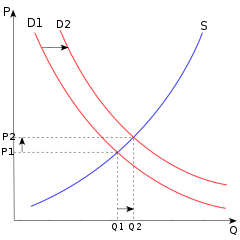Comparative statics
[1] As a type of static analysis it compares two different equilibrium states, after the process of adjustment (if any).Comparative statics is commonly used to study changes in supply and demand when analyzing a single market, and to study changes in monetary or fiscal policy when analyzing the whole economy.Comparative statics was formalized by John R. Hicks (1939) and Paul A. Samuelson (1947) (Kehoe, 1987, p. 517) but was presented graphically from at least the 1870s.[2] For models of stable equilibrium rates of change, such as the neoclassical growth model, comparative dynamics is the counterpart of comparative statics (Eatwell, 1987).Comparative statics results are usually derived by using the implicit function theorem to calculate a linear approximation to the system of equations that defines the equilibrium, under the assumption that the equilibrium is stable.That is, if we consider a sufficiently small change in some exogenous parameter, we can calculate how each endogenous variable changes using only the first derivatives of the terms that appear in the equilibrium equations.For example, suppose the equilibrium value of some endogenous variableas: Dividing through the last equation by da gives the comparative static derivative of x with respect to a, also called the multiplier of a on x: All the equations above remain true in the case of a system ofin the parameters, then the resulting changes in the endogenous variables can be approximated arbitrarily well byNote that if one wants just the comparative static effect of one exogenous variable on one endogenous variable, Cramer's Rule can be used on the totally differentiated system of equationsThe assumption that the equilibrium is stable matters for two reasons.First, if the equilibrium were unstable, a small parameter change might cause a large jump in the value ofstates that stability of equilibrium has qualitative implications about the comparative static effects.In other words, knowing that the equilibrium is stable may help us predict whether each of the coefficients in the vectorSuppose that the quantities demanded and supplied of a product are determined by the following equations: whereSuppose that price adjustments in the market occur according to whereBy stability theory, P will converge to its equilibrium value if and only if the derivativeThis derivative is given by This is negative if and only if g – b > 0, in which case the demand intercept parameter a positively influences the price.So we can say that while the direction of effect of the demand intercept on the equilibrium price is ambiguous when all we know is that the reciprocal of the supply curve's slope, g, is negative, in the only relevant case (in which the price actually goes to its new equilibrium value) an increase in the demand intercept increases the price.The strict concavity of the objective function implies that the Jacobian of f, which is exactly the matrix of second partial derivatives of p with respect to the endogenous variables, is nonsingular (has an inverse).to small changes in q is given by Applying the chain rule and first order condition, (See Envelope theorem).Provided the profit function satisfies the smoothness and concavity requirements, the comparative statics method above describes the changes in the firm's profit due to small changes in the tax rates.A generalization of the above method allows the optimization problem to include a set of constraints.One limitation of comparative statics using the implicit function theorem is that results are valid only in a (potentially very small) neighborhood of the optimum—that is, only for very small changes in the exogenous variables.Another limitation is the potentially overly restrictive nature of the assumptions conventionally used to justify comparative statics procedures.For example, John Nachbar discovered in one of his case studies that using comparative statics in general equilibrium analysis works best with very small, individual level of data rather than at an aggregate level.[6] Paul Milgrom and Chris Shannon[7] pointed out in 1994 that the assumptions conventionally used to justify the use of comparative statics on optimization problems are not actually necessary—specifically, the assumptions of convexity of preferred sets or constraint sets, smoothness of their boundaries, first and second derivative conditions, and linearity of budget sets or objective functions.Stemming from the article by Milgrom and Shannon as well as the results obtained by Veinott[8] and Topkis[9] an important strand of operational research was developed called monotone comparative statics.In particular, this theory concentrates on the comparative statics analysis using only conditions that are independent of order-preserving transformations.The method uses lattice theory and introduces the notions of quasi-supermodularity and the single-crossing condition.
economicsexogenousparameterstatic analysisequilibriumsupply and demandmarketmonetaryfiscal policyeconomymicroeconomicsgeneral equilibriummacroeconomicsJohn R. HicksPaul A. Samuelsonneoclassical growth modelcomparative dynamicsimplicit function theoremlinear approximationfirst derivativesmultipliermatrix of partial derivativesCramer's Ruledeterminantdemand curvetime derivativestability theoryderivativeEnvelope theoremMarshallian demandoperational researchmonotone comparative staticslattice theoryModel (economics)Qualitative economicsFleeming JenkinEconometricaValue and CapitalAndreu Mas-ColellFoundations of Economic AnalysisAmerican Stock Exchange